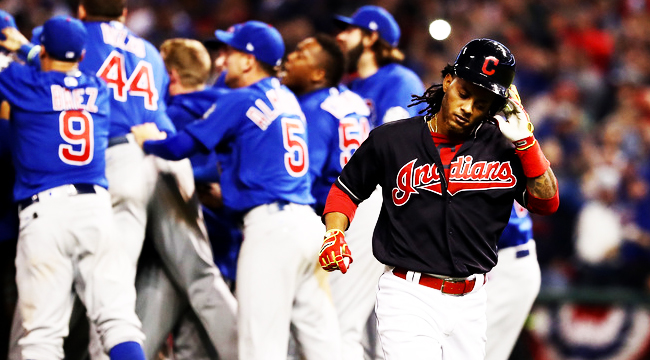
On the evening of Game 5 of the 2016 World Series, a note was written out on the dry erase board in the Wrigley Field press dining room. Usually, it would be a menu board, but with the cafeteria serving as a workspace for the crush of global media, there was no need to scrawl that the soda fountain was working or that the readily visible snacks were indeed there for the taking.
Underneath a Pepsi logo, on what was going to be the last game at Wrigley for the year, regardless of the result, there were four thoughts, each independent and written in different color marker, yet all intertwined.
PURPLE: “Goodbyes are not forever, goodbyes are not the end, They simply mean I’ll miss you until we meet again!”
It’s hard to let go of baseball at the end of the World Series, because it’s more than just the sport itself. You can, after all, watch Winter League games from the Caribbean if you’re so inclined. Baseball is inextricably linked to summer, and when it’s over, winter lasts right up until pitchers and catchers report in February — a time when nobody gets to actually watch any baseball, but it’s enough psychologically to know that you’ve survived the darkest depths of another offseason.
From the middle of February to the end of October — or in the case of some recent seasons, early November — a baseball team is a family. Then they break up and never meet again in the same configuration. Championship teams, though, are said to walk together forever, and that’s certainly true for the 2016 Cubs, breakers of a 108-year title drought in one of the most bonkers World Series in history.
Kris Bryant and Anthony Rizzo? Sure, of course. But it’s not just them. Brian Matusz, the journeyman lefty, pitched one game for Chicago. Joe Nathan, winding down his career, pitched three games. Young infielder Jeimer Candelario got five games, while the quirky and energetic 35-year-old Munenori Kawasaki played 14. All are 2016 Cubs, all on the Baseball Reference page together forever, all recipients of World Series rings, all part of breaking that confounding curse.
RED: “You have the gift of 86,400 seconds. Have you used one to say thank you or one to make someone smile!”
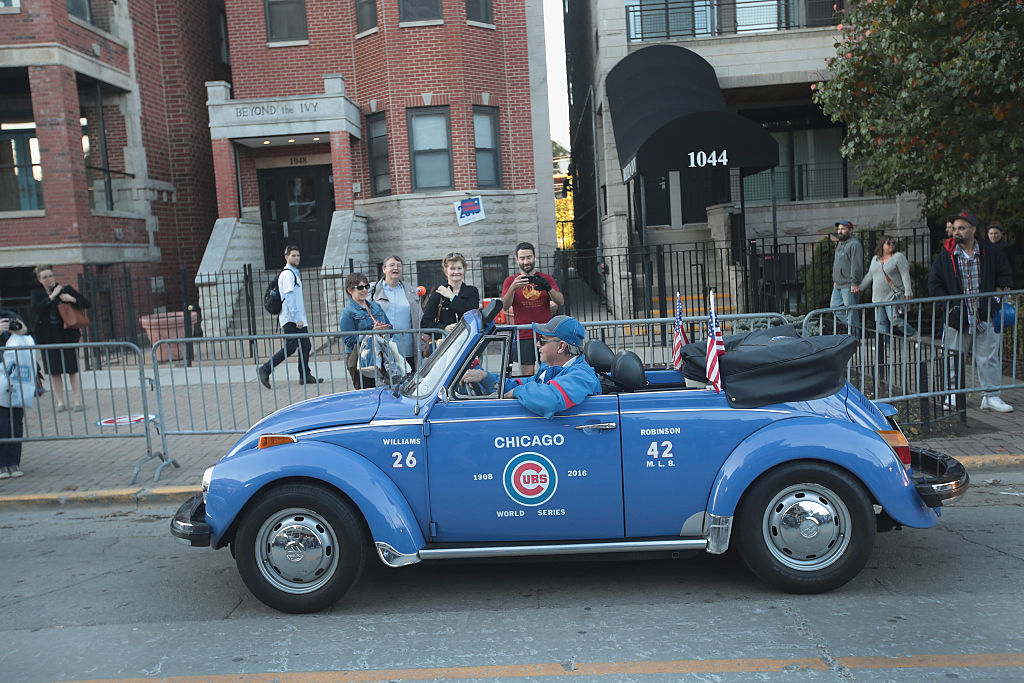
Before Game 3, Chicago was a city of glee, as the Cubs prepared to host their first World Series game since 1945. People were singing in the streets, marveling at merely being alive to witness this scene, and swapping stories with random strangers. Even with a loss that night, the atmosphere both around and inside the ballpark for Game 4 was more of the same. It was the feeling that Disneyland aims to provide but cannot, that this was a place where it was impossible to be anything but happy.
This was after Game 1 in Cleveland had come on the same night as the Cavaliers’ season-opener and ring ceremony for the city’s first major professional sports championship since the Browns back in 1964. The basketball arena and baseball stadium in Cleveland are across the street from each other, so that was wild in its own way. And the city was downright giddy by Game 6, with Cleveland clinging to a 3-2 lead. But there would be a Game 7, which are always nerve-wracking but especially in a city whose team has blown a 3-1 series lead to get there.
Still, the day that stood out most was the day of Game 5 in Chicago. It was a football Sunday, but the Bears’ game wasn’t until the next night. The weather had taken a turn, with an overnight thunderstorm that left everything soggy. Cold air rolled in behind. The Cubs were down three games to one, after back-to-back losses at home, and all that joy of the previous two days had given way to legitimate dread that 71 years of waiting for the World Series to return to Wrigley Field was about to result in only more grief.
One more loss and Cleveland would be celebrating the end of its own 68-year championship drought.
What if the Cubs’ lot in life was only to foster the happiness of others?
BLUE: “Most of the shadows of this life are caused by our standing in our own sunshine.”
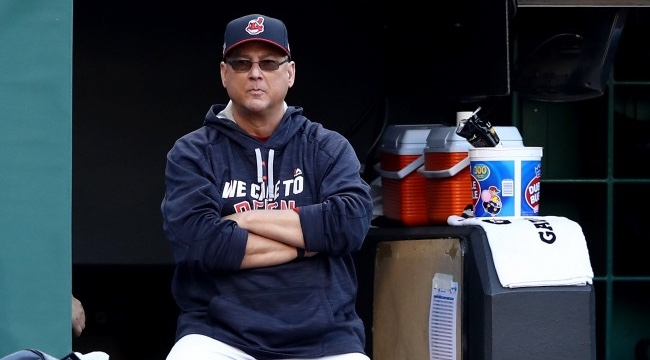
Terry Francona did an incredible job managing Cleveland’s bullpen through the 2016 playoffs, helping a team that lost Carlos Carrasco and Danny Salazar — its two best starters not named Corey Kluber — to reach the World Series for the first time in 19 years. This was a team that had Ryan Merritt, a man whose MLB service time amounted to four games, start the clinching game of the ALCS. The key to Francona’s work was his aggressiveness in turning to his best arms at a moment’s notice. In 15 postseason games, the trio of Bryan Shaw, closer Cody Allen, and relief ace Andrew Miller combined to throw 43.1 innings.
By the World Series, Salazar was back in the fold. His stuff looked good, though his command was spotty, in a Game 2 relief appearance. He was available for Game 5. So was Merritt, the only player on the 25-man World Series roster who went unused across the seven games.
In truth, everyone was available, because even if Cleveland lost, the next day would be an off-day leading into mid-February. One columnist wrote the morning of Game 5, “Would you want Kris Bryant, Anthony Rizzo, and Ben Zobrist to get a second at-bat against Bauer in a game, or would you rather have them face Salazar?”
The column was an ode to Francona aggressively managing his way through October. That night of Game 5, the Cubs’ best hitters got their second at-bats against Bauer. Bryant homered, Rizzo doubled, and Zobrist singled. The runs scored by that trio in the fourth inning were all Chicago needed for a 3-2 win that finally let a World Series crowd sing Steve Goodman’s classic anthem.
Cleveland was 18 outs away from the championship when that fourth inning began. It was as close as they would get.
They never led again.
GREEN: “Thank you for a great season. I will miss each and every one of you.”
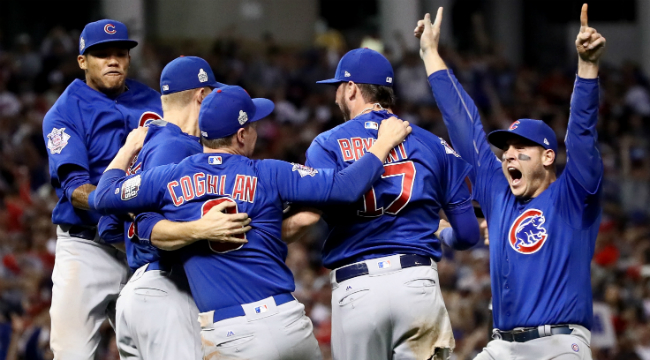
After it was all over, after the champagne dried in the Chicago locker room following Game 7, after the tears had dried in Cleveland’s, after the straggling revelers made their way out of the stadium, and after the last pieces of copy had been filed, I wandered the streets of downtown Cleveland for a long time, having something of an existential crisis: What could I see as a baseball writer — hell, as a baseball fan — that would top what I just saw? The entire series was memorable and historic from the moment it began, rife with passion and drama. Game 7, on its own, was all of that and more.
Think about that Game 7. There was Dexter Fowler’s leadoff homer, Javier Baez’s homer to knock out Corey Kluber in the fifth inning, Jon Lester uncorking a two-run wild pitch to let Cleveland back into what had been a 5-1 game, and David Ross homering off Andrew Miller on the last swing of his major league career.
Then came Aroldis Chapman — suspended by the league at the start of the season for domestic violence — who needed just 14 pitches to cough up a three-run lead, including the inexplicable three-run dinger by Rajai Davis that might hold as the coolest playoff homer ever hit in a losing effort, followed by, of all things, a rain delay after the ninth inning.
The Cubs then scored two runs in the top of the 10th inning. Davis answered (again!) by singling home a run in the bottom of the frame, all before Mike Montgomery came out of the bullpen to get Michael Martinez to ground out, Bryant-to-Rizzo, for the Cubs’ first World Series victory in 108 years.
Again, that’s just some of what happened in this utterly amazing game. It also included history made after the fact, as in Addison Russell drawing the final four-pitch intentional walk in major league history, thanks to an offseason rule change.
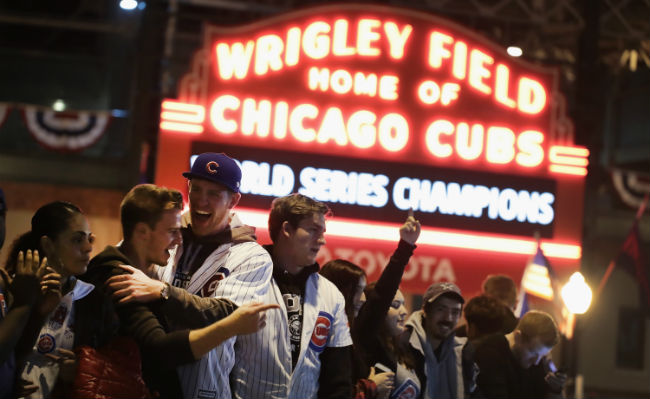
Outside the hotel in Cleveland, I ran into a fellow writer. He was preparing to head to Jacksonville to cover the Notre Dame-Navy football game, a massive comedown from this World Series, and he could not figure out what might approach what had just happened. On the drive to the airport, another writer friend of mine (this one a national baseball writer) was in the same headspace. When you witness two teams, with a combined 174 years without a title between them, battle for seven memorable games, the last of which culminating in one of the most compelling single games in the history of the sport, what happens next?
Maybe someday Montreal beats Las Vegas on Vladimir Guerrero IV’s inside-the-park grand slam in the bottom of the 50th inning.
Maybe Barry Bonds comes out of retirement next year to show these youngsters what’s what.
Maybe someone throws a perfect game to clinch a World Series with six extra-inning nail-biters leading up to that gem.
Maybe the Cubs do it all again in 2124, another 108-year drought and all.
There are possibilities that exist for outdoing the 2016 World Series, but nothing that isn’t so outlandish as to be within the realm of legitimate expectation.
Yet they’re still playing the World Series, here in 2017, and will do so again in 2018, 2019, 2020 and beyond. Baseball is forever racing into the future while chasing its past. What happened last year represents the establishment of another of the game’s many benchmarks, and what’s great about every season is the pursuit of such moments — with every February-to-October marathon and each World Series sprint — managing to establish itself as unique.
It’s why we keep coming back, and why, as we sit at some point in December thinking about how the World Series could still be going on if only the losing team had squeaked out a tying run and set things in motion toward baseball’s ever-present and ever-unapproachable promise of infinity, we always miss it when it’s gone.
Jesse Spector is a freelance writer based in New York City and a former national baseball writer for Sporting News.






